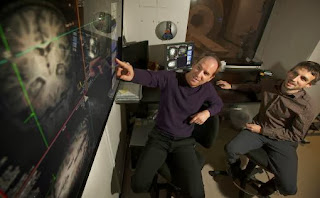Last week, I visited
Rome on a school trip organised by the Latin department. It was an incredible
experience as I learnt a lot about not only the Latin language and Roman
culture, but also I had the experience to learn and use some Italian.
Over the next few days
I am going to write posts about the following:
·
Diary of days
1-4
·
Latin
Language
·
Italian
Language
Day 1
Museo Nazionale Romano
– This museum was built and opened in the 19th century and includes
antiques from between the 5th century BC and the 3rd
century AD. On the ground floor is a collection of statues from the late Roman
Republic, for example, the famous Via Labicana Augustus. This statue is significant because
it demonstrated that Augustus was not only the head of the republic, but also
closely related to the church. On the first floor is a collection of mosaics
and wall paintings, including some from the villa of Livia (Augustus' wife). In my opinion, the most impressive of these
was a vast painting of a garden, which extended on all four walls. The painting
has been preserved incredibly well and it includes vivid trees and flying birds,
showing their wealth.
Coliseum (Flavian
Amphitheatre) - Construction began under the emperor Vespasian in 70AD and was
finished within 10 years by Emperor Titus. There are 80 archways leading into
the centre: many would have been used by the public to find their seats, a few
by the gladiators and one larger arch dedicated to the emperor. The emperor
also had his own seating with places for family members and close friends. The
gladiators and nights would have been seated near the bottom, with the public
sat above them. The common women would have been seated near to the top.
Actors, grave diggers
and former gladiators were not allowed to go to the coliseum at all. Although generally
speaking, slaves would have been banished from the coliseum, some slaves were
present to operate the awning system. We can see where the awnings would have
been secured in square holes in the stone at the top of the building and the
awning would have covered the majority of the seating, making it much cooler.
The arena itself was
83 by 48m. Its name came from the Latin for sand (arena) as sand would have
been applied to the floor often in order to soak up sweat and blood from the
floor. Underneath the arena is the hypogeum, which consists of a maze of
tunnels, used to store the animals. Many different events were held at the
coliseum including gladiator shows, animal hunts and the arena was flooded for
mock sea battles.
Roman Forum – the forum
would have been a central part of Roman life as it was the venue for markets,
public speeches and criminal trials. The forum is situated very close to the
coliseum, between the Palatine and Capitoline hills. There are many fabulous
remains in the forum, including the Arch of Septimius Severus.
The Arch of Septimius
Severus is 23m high and has three arched passageways. The arch was built in
203AD to commemorate the emperor and his two sons, Caracalla and Geta. The
central scene shows the concordia between them and other family members. However,
after the death of Severus, his two sons became joint emperors, until Caracalla
had his brother assassinated. After this he ensured that all mention of Geta
was eradicated, including in the arch. This can be seen especially in the
inscription, which only talks about Caracalla:
IMP (eratori) CAES(ari) LUCIO SEPTIMIO M(arci) FIL(io) SEVERO PIO PERTINACI AUG(usto) PATRI PATRIAE PARTHICO ARABICO ET / PARTHICO ADIABENICO PONTIFIC(i) MAXIMO TRIBUNIC(ia) POTEST(ate) XI IMP(eratori) XI CO(n)S(uli) III PROCO(n)S(uli) ET / IMP(eratori) CAES(ari) M(arco) AURELIO L(ucii) FIL(io) ANTONINO AUG(usto) PIO FELICI TRIBUNIC(ia) POTEST(ate) VI CO(n)S(uli) PROCO(n)S(uli) [P(atri) P(atriae) / OPTIMIS FORTISSIMISQUE PRINCIPIBUS / OB REM PUBLICAM RESTITUTAM IMPERIUMQUE POPULI ROMANI PROPAGATUM / INSIGNIBUS VIRTUTIBUS EORUM DOMI FORISQUE S(enatus) P(opulus)Q(ue) R(omanus)
To the Imperator Caesar Lucius Septimius, son of Marcus, Severus Pius Pertinax Augustus, father of his country, conqueror of the Parthians in Arabia and Assyria, Pontifex Maximus, with Tribunician powers 11 times, triumphing general 11 times, consul 3 times, and proconsul; and to the Imperator Caesar Marcus Aurelius, son of Lucius, Antoninus Augustus Pius Felix [=Caracalla], with tribunician powers 6 times, consul, proconsul, father of his country—**the best and bravest of princes**—on account of the republic restored and the empire of the Roman people increased by their outstanding virtues at home and abroad, the Senate and the Roman people dedicate this arch.
** This phrase was
substituted for one that probably read: ET P(ublio) SEPTIMIO L(ucii) F(ilio) GETAE
NOB(ilissimo) CAES(ari). The translation reads: “and to
Publius Septimius, son of Lucius, Geta, most noble Caesar"
Text and transcription sourced from: http://archive1.village.virginia.edu/spw4s/RomanForum/GoogleEarth/AK_GE/AK_HTML/MA-020.html
Text and transcription sourced from: http://archive1.village.virginia.edu/spw4s/RomanForum/GoogleEarth/AK_GE/AK_HTML/MA-020.html



